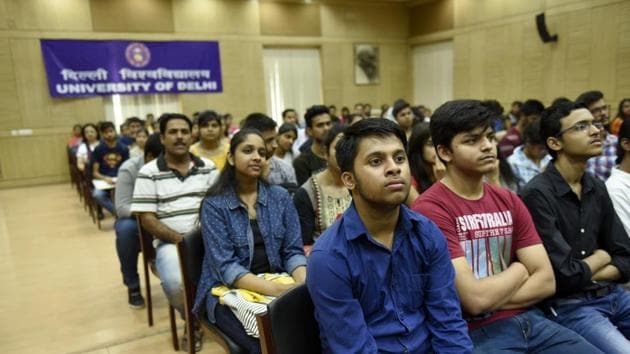Answering the one question in every student’s mind: How to calculate the ‘best of four’?
Campus calling: DU asks its students to calculate the aggregate of the ‘best of four’ subjects, to see if they qualify for admission based on the cut-off
With the time for cutoffs fast approaching, one of the vexed questions on most Delhi University aspirants’ minds is that of how to calculate the ‘best of four’ score.

DU asks its students to calculate the aggregate of the ‘best of four’ subjects, to see if they qualify for admission based on the cut-off. This may sound simple enough, but with different courses having different requirements for calculating the best four, this process can get daunting.
“How to calculate the best of four score and what will the cutoff be is one of the most common questions we get,” said Akansha Gupta, an ex DU student who has been volunteering to help applicants.
HT spoke to experts to simplify this process for aspirants.
Science courses
For most Bachelor of Science courses, Physics and Chemistry are mandatory. If the course has a Biology component, such as Zoology or Botany (Hons) courses, then you would need to have done Biology too. For some courses Mathematics is mandatory.
A few courses such as Biotechnology, etc, will require both Biology and Mathematics.
These courses will be used to calculate your best of four score and the scores for these subjects should have been on a 70/30 basis, where 70% of the marks is for theory and 30% is for practical. If it does not follow this division, then the scores will be adjusted to fit this ratio.
Mathematical Science courses
There are four Mathematical Science courses, such as Mathematics, Statistics, Computer Science and Mathematical Sciences. Mathematics is mandatory to apply for these.
The best of four for these courses is calculated as the aggregate of your scores in one language subject, Mathematics and the scores of any two subjects from List A.
List A is a compilation of academic courses, published by the DU. If any of the elective courses do not fall in list A, then 2.5% will be deducted from your aggregate.
Arts Courses
There are many BA (Hons) and BA programmes that applicants can choose from. The best of four for BA (Hons) programme is calculated as aggregate of the scores in a language subject, the subject in which you would like to do your honours program in and any two subjects from List A.
If you do not include the subject in which you want to do the honours programme in, or if your electives are not from List A, then 2.5% each will be deducted for these.
Commerce courses
Delhi University is well known for its B Com (Hons) and B Com programmes. Students should have studied Mathematics to apply for BCom (Hons).
Students need to use their scores in one language subject (either English or Hindi) and select three subjects from lists C1 or C2 to get their best four score. Like List A, these are compilations of subjects that are prepared by the DU.
However, here there is a small catch. If all three elective courses are from List C1, then the student would not face ant deduction. But for each subject taken from List C2, there will be a deduction of 1%.
The calculation
BA (Hons) courses:
•Best of four for Bachelor of Arts (Hons) programmes is calculated as: one language + the subject in which one wants to do the honours programme + two more subjects from List A to calculate the best four.
•In case if the student does not include the subject they want to do the honours programme in, 2.5% will be deducted from the aggregate.
•For Example:
If you have 96 in Physics, 92 in Chemistry, 90 in English, 94 in Mathematics and 83 in Economics; then the best four would be the aggregate of the first four subjects.
This gives a total of 372, which is 93%.
If this student were to try and do BA (Hons) in History, 2.5% would be deducted and the effective percentage would be 90.5%
BCom (Hons) and BCom courses:
•Best four is calculated as: language + three subjects from lists C1 or C2.
•If the student selects all three subjects from List C1, then there would be no deduction.
•However, if the student uses courses form List C2, then 1% will be deducted for each subject taken from List C2.
•For example:
If you have scored 96 in Physics, 92 in Chemistry, 90 in English, 94 in Mathematics and 83 in Economics, your best four will be calculated based on the first four subjects.
The total will be 372, which gives a 93%.
However, as Physics and Chemistry are not in C1, but fall in List C2, your effective percentage will be 91%. 1% each will be deducted for the two subjects outside of List C1.
List A subjects
•Arabic
•Bengali
•Botany
•Biology/Biotechnology
•Chemistry
•Commerce/ Business Studies
•Computer Science/ Informatics Practices
•Economics
•English
•French
•Geography
•Geology
•German
•Hindi
•History
•Home Science
•Italian
•Legal Studies
•Mathematics
•Music
•Persian
•Philosophy
•Physics
•Political Science
•Punjabi
•Psychology
•Sanskrit
•Sociology
•Spanish
•Statistics
•Urdu
•Zoology
List C1 subjects:
•Mathematics
•Accountancy
•Business Studies/ Commerce
•Economics
List C2 subjects:
•Botany
•Business Mathematics
•Biology/Biotechnology
•Chemistry
•Computer Science/ Informatics Practices
•Geography
•Geology
•History
•Home Science
•Legal Studies
•Philosophy
•Physics
•Political Science
•Psychology
•Sociology
•Statistics
•Zoology
Stay updated with all top Cities including, Bengaluru, Delhi, Mumbai and more across India. Stay informed on the latest happenings in World News along with Delhi Election 2025 and Delhi Election Result 2025 Live, New Delhi Election Result Live, Kalkaji Election Result Live at Hindustan Times.
Stay updated with all top Cities including, Bengaluru, Delhi, Mumbai and more across India. Stay informed on the latest happenings in World News along with Delhi Election 2025 and Delhi Election Result 2025 Live, New Delhi Election Result Live, Kalkaji Election Result Live at Hindustan Times.





